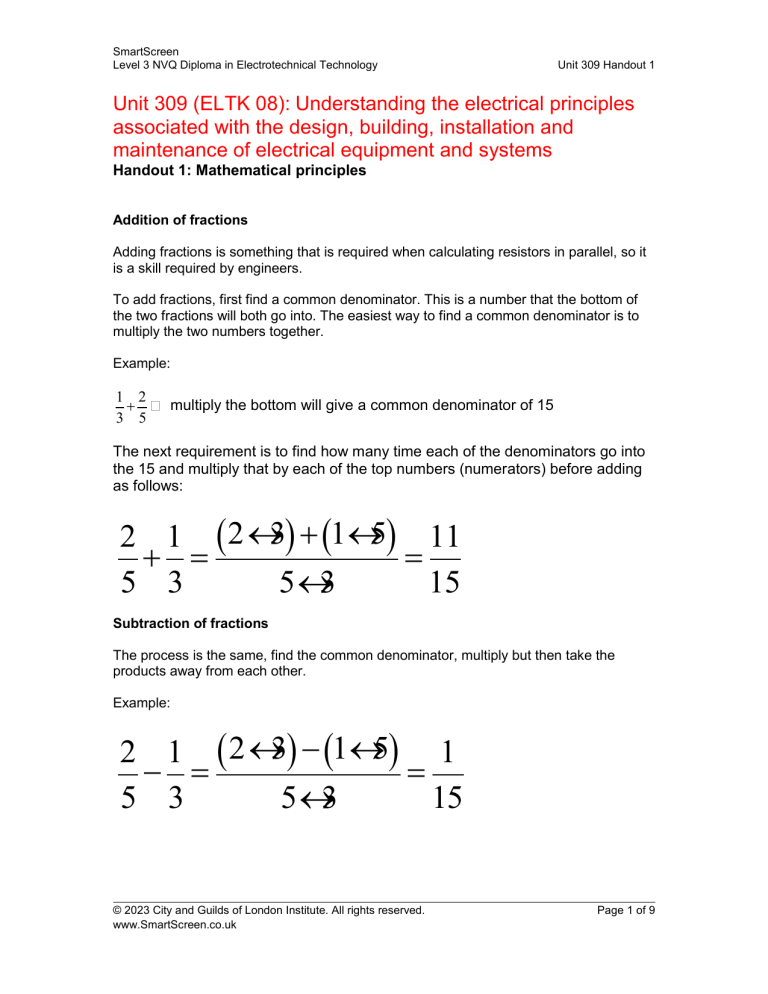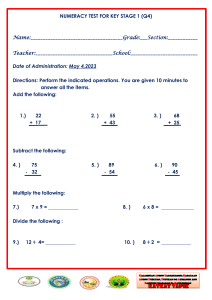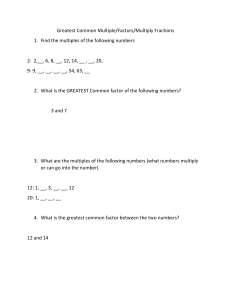Electrotechnical Math: Fractions, Formulas, Triangles, Statistics
advertisement

SmartScreen Level 3 NVQ Diploma in Electrotechnical Technology Unit 309 Handout 1 Unit 309 (ELTK 08): Understanding the electrical principles associated with the design, building, installation and maintenance of electrical equipment and systems Handout 1: Mathematical principles Addition of fractions Adding fractions is something that is required when calculating resistors in parallel, so it is a skill required by engineers. To add fractions, first find a common denominator. This is a number that the bottom of the two fractions will both go into. The easiest way to find a common denominator is to multiply the two numbers together. Example: 1 2 + Þ multiply the bottom will give a common denominator of 15 3 5 The next requirement is to find how many time each of the denominators go into the 15 and multiply that by each of the top numbers (numerators) before adding as follows: 2 1 ( 2 ´ 3) + (1´ 5) 11 + = = 5 3 5´ 3 15 Subtraction of fractions The process is the same, find the common denominator, multiply but then take the products away from each other. Example: 2 1 ( 2 ´ 3) - (1´ 5) 1 - = = 5 3 5´ 3 15 © 2023 City and Guilds of London Institute. All rights reserved. www.SmartScreen.co.uk Page 1 of 9 SmartScreen Level 3 NVQ Diploma in Electrotechnical Technology Unit 309 Handout 1 Multiplication of fractions To multiply fractions simply multiply the numerators and then the denominators. If a common number goes into both the top and bottom, simplification can be achieved. Example: 2 1 2 ´1 2 ´ = = 5 3 5´ 3 15 Division of fractions To divide fractions, simply turn one of the fractions upside down and then multiply. Again, if a common number goes into both the top and the bottom, simplification can be achieved by cancelation. Example: 2 1 2 3 6 1 ¸ = ´ = =1 5 3 5 1 5 5 Percentages The simple approach way to remember percentages is ‘parts in 100’. If you need to find 6% of a figure, divide the number by 100 to find 1/100th of it then multiply by 6 to give you 6%. There are quick methods to find standard percentages, such as 5% by finding 10% and then half of that gives 5%. Example: A lighting circuit has an allowed voltage drop of 3%. What is the actual voltage drop? 230 ´ 3 = 6.9 100 © 2023 City and Guilds of London Institute. All rights reserved. www.SmartScreen.co.uk Page 2 of 9 SmartScreen Level 3 NVQ Diploma in Electrotechnical Technology Unit 309 Handout 1 Transposition of basic formulae This is also known as ‘changing the subject of the formulae’. I=V R In the example on the left, ‘I’ is the subject of the formula and by inserting the values for ‘V’ and ‘R’ the value of the subject ‘I’ can be calculated. If we need to find ‘V’ for example, we must transpose the formula to make ‘V’ the subject. There is one fundamental rule for transposing a formula: Whatever you do to one side of the formula you must do the same to the other side In other words: add the same quantity to both sides of the formula subtract the same quantity from both sides of the formula multiply both sides of the formula by the same quantity divide both sides of the formula by the same quantity take ‘functions’ of both sides of the formula: for example, square both sides, find the reciprocal of both sides. EXAMPLE 1 I = V / R – make V the subject of the formula. I = V R (I is currently the subject of the formula) The question is ‘make V the subject of the formula’. This means that ‘V’ must be put on its own on one side of the equals sign and the other terms must be on the other side. To do this, first multiply both sides by R Now cancel through: I×R = I×R = I×R = V×R R V×R R V © 2023 City and Guilds of London Institute. All rights reserved. www.SmartScreen.co.uk Page 3 of 9 SmartScreen Level 3 NVQ Diploma in Electrotechnical Technology Now reverse the formula: 𝐕 = Unit 309 Handout 1 𝐈×𝐑 EXAMPLE 2 I = V / R – make R the subject of the formula. I = V R (I is currently the subject of the formula) The question is ‘make R the subject of the formula’. This means that ‘R’ must be put on its own on one side of the equals sign and the other terms must be on the other side. To do this, first multiply both sides by R Now cancel through: Now divide both sides by I: Now cancel through : I×R = I×R = I×R I×R I I×R I = 𝐑 = = = V×R R V×R R V V I V I 𝐕 𝐈 Triangles Throughout electrical science there is a need to use maths related to triangles. Applications include: Power triangles Impedance triangles Light calculations The main requirement is to find missing sides or angles on right hand triangles. This can be done using Pythagoras’ theorem. This states that hypotenuse of a right angle triangle can be found by taking the square root of the sum of the other sides squared. 𝐚 = √𝐛 𝟐 + 𝐜 𝟐 © 2023 City and Guilds of London Institute. All rights reserved. www.SmartScreen.co.uk Page 4 of 9 SmartScreen Level 3 NVQ Diploma in Electrotechnical Technology Unit 309 Handout 1 a b Φ c Where: a = hypotenuse b = opposite c = adjacent If two sides are known, the third can be found by rearranging the Pythagoras formula. 𝐛 = √𝐚𝟐 − 𝐜 𝟐 𝐜 = √𝐚𝟐 − 𝐛 There are other ways to work out missing values if you know one side and one of the angles is known other than the 90°. SOHCAHTOA This can be broken down into three parts: 𝐎𝐩𝐩𝐨𝐬𝐢𝐭𝐞 𝐬𝐢𝐧 𝜱 = 𝐡𝐲𝐩𝐨𝐧𝐞𝐧𝐮𝐬𝐞 © 2023 City and Guilds of London Institute. All rights reserved. www.SmartScreen.co.uk Page 5 of 9 SmartScreen Level 3 NVQ Diploma in Electrotechnical Technology 𝐜𝐨𝐬 𝜱 = Unit 309 Handout 1 𝐀𝐝𝐣𝐚𝐜𝐞𝐧𝐭 𝐇𝐲𝐩𝐨𝐭𝐞𝐧𝐮𝐬𝐞 𝐎𝐩𝐩𝐨𝐬𝐢𝐭𝐞 𝐭𝐚𝐧 𝜱 = 𝐀𝐝𝐣𝐚𝐜𝐞𝐧𝐭 Statistics Average values are used in electrical science. There is a need to understand average power for example and RMS (root mean square). This is needed so it is possible to work out the heating effect of current in a circuit or equipment. The three types of averages are: Mean Add the numbers up and divide by the amount of numbers in the sequence. Number range: 2, 2 ,4 ,4 , 4, 6, 6 The mean is found as follows: 𝐦𝐞𝐚𝐧 = 𝟐+𝟐+𝟒+𝟒+𝟒+𝟔+𝟔 =𝟒 𝟕 Median The median is the middle number when the number range are put in order from lowest to highest as follows: 2, 2 ,4 , 4, 4, 6, 6 Counting from either end until the middle number is reached. If there were 2 numbers in the middle, the mean is taken and that becomes the median. © 2023 City and Guilds of London Institute. All rights reserved. www.SmartScreen.co.uk Page 6 of 9 SmartScreen Level 3 NVQ Diploma in Electrotechnical Technology Unit 309 Handout 1 Mode The most is sometimes referred to as the MOST common number in a number range. For the same range used before the most common number is 4 also as it occurs 3 times. Range The range is defined as the largest number take away the smallest number when the numbers are put in order from lowest to highest as follows: 2, 2 ,4 , 4, 4, 6, 6 6–2=4 The range is also 4 in this example. © 2023 City and Guilds of London Institute. All rights reserved. www.SmartScreen.co.uk Page 7 of 9 SmartScreen Level 3 NVQ Diploma in Electrotechnical Technology Unit 309 Handout 1 Useful Formulae VOLTAGE = I.R = P/I = P.R CURRENT = V/R = P/V = P/R = P/I2 = V2/R RESISTANCE V/I = POWER 2 V /P = = V.I = I2.R In series: R t = R1 + R 2 + R 3 etc RESISTORS 1 1 1 1 = + + R t R1 R 2 R 3 in parallel: etc KIRCHHOFF’S LAWS Voltage: VT = V1 + V2 + V3 + etc in a Series circuit Current: IT = I1 + I2 + I3 + etc in a Parallel circuit RESISTIVITY CHARGE (Quantity) CAPACITORS R=ρ× RL L a Q = It or R 1/a Q = VC in parallel: Ct = C1 + C2 + C3 etc in series: 1 1 1 1 = + + Ct C1 C2 C3 etc = B.A mmf = NxI H = E = n×l L B × l × v (v = velocity) E = ELECTROMAGNETISM INDUCED EMF FORCE ON A CONDUCTOR F = BH (I2 − I1) t B × I × l Newtons −L × ENERGY in a magnetic field: ½.L.I2 Joules STORED in a capacitor: ½.C.V2 Joules EFFICIENCY Efficiency = Output power Input power MECHANICS Force = Mass x Newtons Torque = Force x Distance Work Done (WD) = Force x Distance Energy = Joules © 2023 City and Guilds of London Institute. All rights reserved. www.SmartScreen.co.uk Page 8 of 9 SmartScreen Level 3 NVQ Diploma in Electrotechnical Technology Unit 309 Handout 1 Joules = Watts x Seconds Joules = Newton Metre Z = √R2 + X 2 POWER FACTOR p.f. = POWER FACTOR p.f. = R Z P VA PYTHAGORAS © 2023 City and Guilds of London Institute. All rights reserved. www.SmartScreen.co.uk Page 9 of 9



